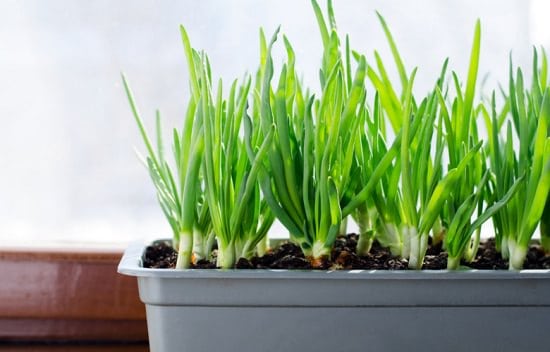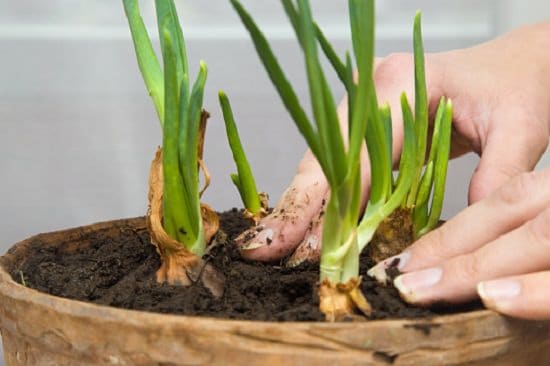If you want a consistent, fresh supply of this versatile vegetable, then Growing Onion in Pots is the best option. Learn how you can grow them in limited space!
Onions (Allium cepa) are some of the most versatile vegetables that can be used in almost every dish. Growing Onion in Pots is the best way to enjoy them fresh in your cuisines as there’s nothing like eating your own, homegrown veggies!
Check out our article on growing green onions in pots all year here!
Onion Varieties
While planting onion sets, you must get familiar with the varieties as all have different needs and daylight requirements. The onion varieties fall into the following categories:
Short day onion variety All varieties from this category are sweet, excluding red creole. They flourish in early spring/winter and, therefore, ideal for southern states and other warm climate regions. It includes-Yellow Sweet Spanish, First Edition, Red Wethersfield, Aisa Craig, Buffalo, Norstar, and Red Florence.
Long-day onion variety does best in late spring-summer. They are ideal for growing in northern regions, perfect for late spring-summer. It includes Stuttgarter, White Bermuda, Red Burgundy, Crystal Wax White Bermuda, Hybrid Yellow Granex, Southern Belle, and Texas 1015-Y Supersweet.
To Know About Amazing Onion Skin Uses, Click here!
Varieties That You Can Grow in Pots
- Ailsa Craig is an heirloom long day variety that has a mild sweet taste with golden skin.
- Italian Torpedo has an elongated shape with red-pink skin and a mild sweet taste.
- Red Burgundy is a short day variety and grows in purple-red skin.
- Utah Yellow Sweet Spanish matures in approximately 115 days and has a sweet flavor.
- White Grano grows in white, globular, large bulbs that get ready to harvest in 100 days.
- Storage Onions remain fresh for a more extended period. They have crispy flesh.
The onions are also further classified based on their colors. Yellow or brown onions are famous for their everyday use. Similarly, red onions are best when they are used fresh and are also known as purple onions. Lastly, white onions, the traditional ones, are mainly used in Mexican dishes.
Note: While Growing Onion in Pots, you can use both indoor and outdoor varieties. Onions can be grown indoors under grow lights with timer.
Choosing the Pot
- Pick a container that is at least 8-10 inches deep and as wide as possible.
- Consider using deep window boxes, tubs, or other wide containers.
- Make sure that your pot has enough drainage holes.
- The diameter of the container mainly depends on the number of onions you have planned to grow, as onion plant spacing is important.
- Keep the container a little off the ground with the help of a stand.
Planting Time for Onions in Pots
You can easily grow onions in pots but keep in mind that this root vegetable is sensitive to timing and seasons.
- For regions with frigid winters, you can grow them in late March or April.
- Regions with mild temperatures, you can grow them in late fall or winter.
- If you are going to sow the seeds in autumn, they won’t be ready till summer. You also have to protect them from winters in cold areas.
Tip: If you are someone who is not living in a hot tropical and subtropical climate, you can grow onions in containers during summers as well.
Propagation
When planting, you have a choice of either using seeds, transplants, or sets. Onions bulbs or sets are hardier and can stand up to poor soil conditions and weather better than seeds.
- Transplants are usually seedlings that are planted at the beginning of the season and sold in bunches from nurseries. They bud quickly but are also susceptible to diseases.
- Sets are the easiest to plant, quickest in maturing, and disease resistant. However, sets are prone to prematurely forming a flower stalk. While planting, put them about 1 inch in the soil with the pointy end up.
- Seeds take up to four months to mature. To overcome this, ensure you sow seeds 6-8 weeks before the last frost of the season and place the container indoors. While sowing, the seeds should be about ½ inch deep and 1-2 inch apart from each other.
- Bulbils are small bulbs that grow above mature flower stalks. You can plant these tiny onions in fall or spring, 1/2 inch deep.
- Onion Bottom, which is the root end of an onion that can be used to grow new onions. Just chop away the bottom part, let it dry, and hang it over a bowl of water using toothpicks. Plant it in a pot when it grows roots.
Note: Make sure that you plant a fresh set of seeds every season, as they have a short lifespan. When the seedlings are about 3 inches long, you can move them outdoors.
Requirements for Growing Onions in Pots
Location
Onions grow well in full sun, with at least 6 hours of sunlight. You can also place your container in part sun, but it’ll reduce the harvest. Avoid growing them in the shade unless you’re looking only for green onions.
For planting indoors, a window box on a south or west-facing windowsill is what you’ll need. You can also place the pot outdoors for 3-4 hours in the morning sun or supplement with the grow lights.
Soil
Your container onions will do just fine in neutral, slightly acidic soil pH and won’t mind slightly alkaline growing medium either. Potting soil that is loamy and rich in organic matter is recommended for growing onions in pots.
Before you start planting, you can mix 1/3 part of compost or well-rotted manure to enrich the soil. Doing this minimizes the amount of care you give to your plants throughout the growing period, other than light and water.
Watering
While growing onions in pots, use a lot of water, especially if you are using ceramic planters.
- Watering should be done when the top 1 inch of the soil becomes dry. Add water slowly and thoroughly until you see some of it trickle through the drainage holes.
- Check your onions, as often as possible, since container soil dries faster, especially in the hot weather.
- If you want your onions to be sweeter, water them more than you usually do, only being careful not to make the soil soggy.
- Avoid uneven watering. And, reduce watering 3-4 weeks prior to harvesting onions.
- If growing in a sunny position, consider mulching the pot.
Spacing
Spacing depends on the variety of onion you are growing. For smaller ones, space them 2-3 inches apart. If you are growing full-sized onions, spacing should be 4-5 inches.
Temperature
Onions can adapt well in various climatic conditions, including sub-tropical, temperate, and tropical climates. As pointed out earlier, there are short-day and long-day onions. The ideal temperature for bulb development is 70 F (21 C) to 75 F (24 C) and around that range, onions grow best.
Onion Plant Care
Fertilizer
If you premixed compost in your potting mix at the time of planting, then you don’t have to fertilize this vegetable often.
- Avoid using fertilizers with a high level of nitrogen as it may lead to more top growth.
- A low nitrogen fertilizer like 5-10-10 should be fine.
- You can also feed your onion plants with any balanced liquid fertilizer.
- Fertilize once in 3-4 weeks.
- Alternatively, you can also use compost tea and fish emulsion.
Pests and Diseases
While growing onions in pots, be careful, as they can be affected by thrips and onion maggots. To control the pests, use mild insecticidal soap or neem oil spray. Also, apply an organic fungicide to prevent fungal diseases.
Check out Our Article on Getting Rid of Pests Naturally here!
Control Weed
It’s possible that some unwanted plants may erupt to compete with your onions plants in containers, especially in large pots and tubs. Remove them by handpicking as soon as you see them.
Harvesting
For Bulbs: Once the onion tops turn yellow and become soft and dry, it’s time to harvest. You can also bend the top at this time to speed up the process. Pick the bulbs when the tops turn brown.
For Green Onions: Pick the tops when they reach a height of 7-8 inches. They taste best when they’re fresh and tender.
After harvesting, store onions in a dry place. They can stay for up to 10 months when kept at room temperature.








